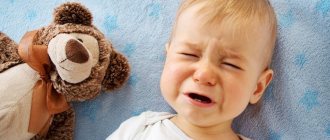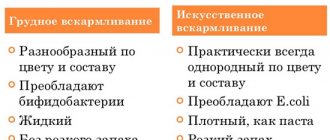Causes
Diarrhea in children is a common occurrence. A fragile body reacts sharply to external and internal stimuli, especially in children under 6 years of age. The immune and digestive systems have not yet fully developed. In newborns and infants, diarrhea with high fever is provoked by the following factors:
- congenital intestinal pathologies;
- infection with Staphylococcus aureus;
- rotavirus infection;
- early introduction of complementary foods and transfer of the child to the common table;
- intolerance to cow's milk protein, eggs, gluten.
The main causes of diarrhea in a child after 1 year:
- food poisoning;
- teething;
- viral or bacterial infection - E. coli, salmonellosis;
- colds;
- scarlet fever;
- helminthic infestations;
- side effects of medications - antibiotics, anti-inflammatory and hormonal drugs;
- binge eating;
- consumption of exotic foods;
- contact with street animals;
- allergy;
- stress;
- complication of a previous illness.
Diarrhea in combination with high fever most often occurs in the summer. During this period, the child has access to sand, ponds, unripe berries and fruits.
Possible causes of diarrhea with high fever in older children:
- chronic gastrointestinal diseases (gastritis, colitis, pancreatitis, etc.);
- disruption of enzyme activity;
- hormonal pathologies;
- increased physical and mental stress.
Against the background of food poisoning, body temperature rarely rises above 38°. Only if we are talking about severe poisoning. The temperature in this case may rise to 39–40°.
The most dangerous foods that, when poisoned, cause severe diarrhea and fever: meat, fish, eggs, confectionery, canned food, dairy products. Their spoilage or violation of storage conditions causes the proliferation of pathogenic microbes, which are the causative agents of salmonellosis, botulism, listeriosis, and clostridiosis. As a result of the vital activity of bacteria, a poison is released, which provokes severe intoxication of the child’s body.
Inedible mushrooms, poisonous herbs, and berries pose a particular danger to children. Even edible types of mushrooms pose a threat if they are collected along the highway, near industrial enterprises. They absorb toxic substances like a sponge.
If a child who attends kindergarten or school has diarrhea combined with a temperature above 38°, in 90% of cases the infectious nature of the underlying disease is detected.
Prevention
To prevent your baby from suffering from diarrhea with fever, you need to follow certain rules. They just help to avoid this unpleasant and insidious disease.
- Feed the baby according to his age, exclude food for adults from the menu (mushrooms, chocolate, seafood, smoked food).
- Strengthen immunity.
- Follow the rules of hygiene - wash your hands before eating, rinse berries, vegetables and fruits before eating.
- Swim only in clean and tested waters.
- A nursing mother should follow a diet.
- High-quality nutrition - foods without dyes, fast food, flavor enhancers, expired foods, and soda should be excluded from the diet.
- Balanced diet.
- Eliminate stressful situations, create a favorable psychological environment.
- To boil water.
- Refrain from contact with sick people.
- Conduct heat treatment of chicken eggs, fish, meat, and fresh milk.
We recommend: Reasons for the development of white diarrhea in a child
With proper care and a healthy diet, the child will not develop fever or diarrhea. We must remember that preventing a disease is much easier than treating it.
How to determine the cause of diarrhea
The type of intestinal disorder can be determined by accompanying symptoms and parental observations of stool characteristics.
Signs of food poisoning
The baby first of all complains of pain in the stomach, because poor-quality food damages the mucous membrane. Diarrhea may be accompanied by vomiting and an increase in temperature to 37.5–38°. Poor quality food is difficult to digest, causing rotting and fermentation in the intestines. As a result, bad breath occurs. A clear sign of food poisoning is cold extremities. Vomit resembles the smell of acetone.
Symptoms of intestinal infection
The same infection can manifest itself differently in a baby. The nature of the course depends on the characteristics of the immune system. E. coli can enter the gastrointestinal tract with food, through contact with a sick person contaminated with sand or soil. Stools due to intestinal infection are watery and green in color. The stool sometimes contains inclusions of mucus and blood. Most often, loose stools appear suddenly and do not depend on meals. The baby develops gas, loses appetite, and defecation does not bring relief.
A severe intestinal infection of a bacterial or viral nature is accompanied by obvious signs of intoxication:
- fever;
- fever;
- decreased blood pressure;
- severe weakness;
- bouts of crying give way to sudden apathy.
Diarrhea due to colds and flu
Diarrhea is combined with a sore throat, runny nose, cough and high fever. In this case, loose stools are one of the signs of a serious illness. Most often, intestinal upset occurs with influenza, otitis media, sore throat, and nasopharyngitis. Diarrhea can be caused by medications for fever and pain based on ibuprofen and paracetamol.
Combination of diarrhea and rash
The rash indicates an allergic reaction caused by medications. Another option is that the child fell ill with scarlet fever, measles or rubella. The rash is characteristic of an enterovirus infection.
Teething
Stool loosening in children under 3 years of age is often associated with teething. The condition can be recognized by swollen gums. The temperature can rise to 40° and above. The lower and upper molars begin to cut at 1–1.3 years, which is the most common cause of diarrhea in a one-year-old child. The temperature may bother the baby for 2-3 days until the gum inflammation subsides. Molars and canines take a long time to cut, so symptoms may recur after some time.
Allergy to drugs
Intestinal upset and an increase in body temperature to 38.5–39° are caused by drugs containing iron. This happens when a child has an individual intolerance to these drugs. An additional sign of an allergy is hives. It manifests itself as swollen blisters on the skin.
Food allergies
The temperature rises due to allergies in rare cases. A combination of fever and diarrhea occurs if the child has eaten a large portion of a product that causes an immune reaction. Food allergies provoke swelling and irritation of the gastrointestinal mucosa. There are pieces of undigested food in the stool.
Dysbacteriosis
The condition may be accompanied by diarrhea and fever. The balance of intestinal microflora is disrupted due to a decrease in the number of beneficial bacteria. The digestion process slows down. Food is not completely absorbed; undigested particles irritate the intestines, which leads to inflammation of the large and small intestines. In the chronic course of the disease, the stool becomes liquefied and the temperature rises to 38° degrees. A characteristic sign of dysbiosis is the presence of undigested food in the stool.
Primary actions for diarrhea and fever in children
When you discover these phenomena, the first thing you need to do is not to panic, pull yourself together. It is necessary to analyze the complex of possible causes of illness:
- what food the baby ate the day before;
- was there any communication with peers suffering from intestinal problems;
- check the oral cavity, maybe teeth are cutting;
- see if there is a rash or signs of itching on the skin.
Sometimes even at a temperature of 37°, parents are ready to give their children antibiotics. This should not be done until the exact cause of the disease is established. The disease did not necessarily arise due to infection.
Important. What should you do immediately? With diarrhea and extreme heat, dehydration can occur, so you should not delay visiting a doctor. Whether outpatient or in a hospital, treatment must be comprehensive; parents must strictly follow the doctor’s instructions.
If a child, in addition to fever, has diarrhea with blood, then you should read a separate article on our website.
Some mothers think that green diarrhea is the norm, that it will go away on its own, or that it is a sign of poisoning, this is not so. Green diarrhea in a child can mean several problems.
Please note that if a child has only vomiting and fever without diarrhea, then this material will help you.
First aid
If a child has a high fever in combination with diarrhea, parents should call a doctor.
First aid for diarrhea includes the prevention of dehydration and demineralization of the body. Most reactions in the body occur with the participation of water; a sudden loss of fluid is very dangerous for the baby. To restore the water-salt balance, the baby is given a solution of electrolytes. Products in this group are produced in powder form. A solution of Gastrolit and Humana is suitable for a child.
If there are no signs of dehydration, children under 3 years of age are given a prophylactic dose of the drug - 1-2 teaspoons every 10 minutes. For older children, the volume of the solution is increased depending on body weight. During the first 6–10 hours you need to drink about 200 ml per 5 kg of weight. To avoid nausea, rehydrants drink from a spoon. For young children, it is convenient to inject the solution using a medical syringe without a needle.
Dehydration of the body is recognized by signs:
- sunken eyes;
- facial features become sharper;
- lethargy;
- decreased firmness and elasticity of the skin;
- dry mucous membranes;
- joint pain;
- no urination for more than 6 hours.
With such symptoms, the baby usually refuses to drink. To avoid the consequences of dehydration, the solution must be given, even if it is done through force.
If pharmacy electrolytes are not at hand, the composition is prepared at home. Dilute 1 teaspoon of table salt in a glass of boiled water. From the liquid you can drink dried fruit compote or clean water.
With the help of loose stools, the body is cleansed of toxins and microbes. During the first 4–6 hours of manifestations of the disease, diarrhea cannot be stopped with drugs based on loperamide, much less antibiotics. Fixing agents for intestinal infections lead to the retention of microbes and harmful compounds in the body. Antibiotics not only will not help, but will also harm if the cause of diarrhea is a viral infection or dysbacteriosis.
When a child has a stomach ache or fever, and the parents are sure that the symptoms are caused by food poisoning, it is necessary to induce rescue vomiting or give a cleansing enema. The baby must first drink enough water. Antispasmodics - No-Shpa, Trimedat - will help relieve abdominal pain.
If the temperature has risen above 38.3°, it is necessary to bring down the fever with drugs based on paracetamol (Cifecon) or ibuprofen (Nurofen). If the baby is vomiting, it is better to use these remedies in the form of rectal suppositories. Antipyretics can be given at intervals of at least 8 hours.
In cases where the temperature rises again before this period of time, wipe with water. Vinegar and alcohol solutions should not be used for the procedure for diarrhea and vomiting. The plate is filled with water at room temperature. The child is wiped with his hands in the places of the body where the main vessels pass - the bends of the elbows, knees, armpits, neck, inguinal folds.
In addition to saline solutions and antipyretics, before the doctor arrives, the baby can be given an absorbent - Activated carbon, Smecta, Neosmexin, Enterosgel. These remedies provide relief from diarrhea and high fever, as they bind toxins and microbes and remove them from the body.
Home remedies include rice water and chamomile infusion.
Other remedies can be used only after consulting a doctor, so as not to aggravate the baby’s condition.
Therapy
For fever and diarrhea in children, treatment is prescribed for the underlying disease, which has resulted in a serious and unpleasant disorder. Also, the baby’s stomach functions are improved and a large loss of fluid from the body is prevented.
Only a qualified doctor knows how to treat a child. He prescribes drug therapy and prescribes a strict diet. You can also use folk remedies (mint infusion, chamomile/mint tea, rice water, etc.), but this method of therapy can be used after medical consultation.
Diagnostics
To clarify the cause of intestinal disorder, a number of tests are prescribed:
- general and biochemical blood test;
- sowing stool for bacteria and viruses, dysbacteriosis (will be ready in 5–7 days);
- coprogram.
Additionally, a urine test and abdominal ultrasound may be prescribed. The main diagnostic method for diarrhea with fever is a visual examination of the patient, stool and assessment of blood counts.
A stool test is done for about a week - the test results often come when the child is already recovering.
Treatment
If a child has diarrhea and high fever, the approach to treatment is complex, including medications, drinking and bed rest, and a gentle diet.
What medications are prescribed
The doctor selects a treatment regimen based on the symptoms. Treatment includes drugs to reduce the temperature (if it rises above 38.3°), drugs to stop diarrhea, relieve pain, and prevent dehydration.
Based on clinical signs and blood tests, medications may be prescribed:
- enterosorbents – Polysorb, Smecta, Polyphepan;
- anti-vomiting medications – Cerucal, Motilium, Diakarb;
- antiviral drugs - Kagocel, Arbidol, Kipferon;
- antibiotics – Amoxicillin, Furazolidone, Levomycytin;
- probiotics – Linex, Bifidumbacterin, Hilak forte, Acipol;
- antipyretics – Efferalgan, Nurofen, Ibufen.
If there are signs of dehydration due to diarrhea and high fever, the child will be hospitalized. In a hospital setting, for moderate and severe pathology, intravenous infusion of saline solution is prescribed using a dropper.
Diet
Therapeutic nutrition includes dishes that restore gastric motility and restore intestinal microflora. Portions should be small so as not to burden upset digestion. At high temperatures, heavy dishes are difficult to digest, so the menu is based on light dishes:
- well-cooked porridge;
- slimy soups made from cereals and vegetables;
- jelly;
- vegetable purees.
For a while, exclude fresh fruits, dairy products, and sweets. Dishes are steamed or boiled. For the first 3–5 days, crushed food is consumed. Steam cutlets and meatballs are prepared from meat. The therapeutic diet is followed for 1–2 weeks.
In infants under one year of age, formula milk is temporarily replaced with plant-based nutrition. Infectious diarrhea disrupts the production of enzymes that break down lactose. Temporary lactose deficiency develops. Milk is not digested and goes straight into the intestines, which worsens diarrhea.
If an intestinal infection is suspected, infants are temporarily transferred to a dairy-free formula. After a 2-week diet, natural feeding can be resumed. Pediatricians have different opinions regarding stopping breastfeeding during diarrhea. Some experts argue that switching the baby to formula will only worsen his condition.
Complications
Possible complications of diarrhea in combination with high fever:
- dysbacteriosis;
- convulsive syndrome;
- loss of consciousness due to severe dehydration;
- chronic diseases of the gastrointestinal tract – gastritis, pancreatitis, colitis;
- allergic reactions – atopic dermatitis, urticaria;
- renal failure.
When parents take preventive measures immediately, the risk of consequences is significantly reduced. Diet plays an important role in the treatment of diarrhea complicated by high fever. Therapeutic nutrition helps restore mucous membranes and replenishes vitamins and minerals.
We recommend: How and with what to treat diarrhea during pregnancy?










